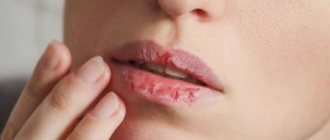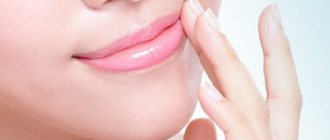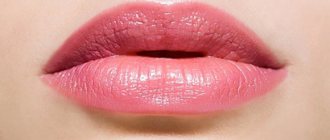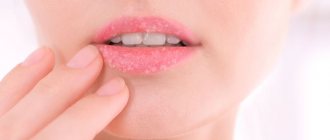Causes
There are many reasons for numbness, but in most cases it occurs due to problems with the spine. Namely, osteochondrosis of the lumbosacral region. The situation is significantly aggravated if the spine is unstable or the woman has an intervertebral hernia.
In this case, numbness is often combined with such unpleasant symptoms as a weakened urge to urinate or defecate, and muscle atrophy in the lower half of the body. In this case, both one muscle and entire groups can atrophy.
In addition to this, there are many other reasons why the labia become numb. These can be listed:
- impaired glucose tolerance;
- pregnancy, postpartum period;
- Bladder irritation due to chronic stress;
- coxarthrosis;
- multiple sclerosis or some other severe diseases of the central nervous system;
- inflammatory damage to the uterus and/or appendages;
- severe cerebrovascular accidents;
- staying in an uncomfortable position for a long time, riding a horse or bicycle;
- pathologies of the large intestine;
- pathologies of the genitourinary organs;
- abdominal aortic aneurysm;
- poor circulation in the lower body;
- injuries to the legs, pelvic organs or spine;
- tumors in the spine, gastrointestinal tract or urinary tract (they can be either benign or malignant);
- sedentary lifestyle, bad habits, excessive consumption of fatty foods).
Possible causes of numbness of the labia
There are many pathologies of the female genital organs, they cause a lot of inconvenience. But recently, very often the female half of humanity has begun to complain that their labia majora are numb. This inconvenience is not accompanied by pain, but there is a feeling of discomfort. Many ladies often simply do not pay attention to such a problem, but as practice has shown, such symptoms can become harbingers of serious diseases. Therefore, it is better to consult a doctor even if numbness appears several times and then not for long.
Diagnostics
If a woman experiences numbness in her labia, she should not try to self-diagnose or self-medicate. The causes of this condition can be quite dangerous, so in this case it is better to trust a qualified specialist.
First of all, you need to contact a therapist, and after conducting a survey, he will refer the patient to a more specialized specialist. As a rule, see a gynecologist or neurologist. In rarer cases, consultation with other doctors may be necessary.
Based on the woman’s clinical picture, the specialist can prescribe a number of medical tests for her. Including these:
- clinical blood test;
- blood test for the amount of lipoproteins, triglycerides, glucose, and cholesterol;
- Analysis of urine;
- radiography of the spine;
- CT;
- MRI;
- electromyography;
- Ultrasound;
- duplex scanning;
- angiography.
Therapy
Treatment for numbness will directly depend on the causes of its occurrence. So, in order for an unpleasant symptom that arises as a result of being in an uncomfortable position to disappear, it is usually enough just to walk for a few minutes. Numbness during pregnancy and the postpartum period may be normal. It will disappear on its own after the body recovers.
If there is an intervertebral hernia, the patient is prescribed physical therapy, massage and anti-inflammatory medications. In severe cases, treatment can be performed surgically.
If the cause of the problem is an irritated bladder as a result of constant stress, the woman may be advised to take antidepressants, tranquilizers, sedatives and psychotherapy.
If glucose tolerance is impaired, the patient will be prescribed a special diet and medications that help lower blood sugar levels. Losing weight may also be helpful in this case.
Inflammatory diseases of the genitourinary organs are traditionally eliminated with the help of antibiotics and drugs from the NSAID group.
If the cause is a circulatory disorder, doctors look for the organ that is malfunctioning and treat it.
Regardless of the causes of numbness, during treatment a woman should give up bad habits, take walks in the fresh air, eat healthy foods and vitamin-mineral complexes, and sleep enough hours. All this together will contribute to a faster recovery.
Consequences
Numbness itself does not cause harm to the body, which cannot be said about the diseases that provoked it.
They, in turn, can give the following complications:
- paresis;
- paralysis of the lower body;
- sexual coldness;
- dysfunction of the sphincter of the bladder and rectum;
- spontaneous termination of pregnancy;
- infertility.
It is worth noting that some time passes from the onset of numbness to the development of these complications, which means that they can be prevented if desired. To do this, you need to see a doctor and undergo a course of treatment. And the sooner this is done, the better.
In most cases, discomfort in the genital area is a signal of health problems. If you hope that the unpleasant sensations will go away over time, you can prolong the illness, which will certainly lead to dangerous complications, including cancer.
Photo 1: If pain occurs in the labia area, you should see a gynecologist, and, if necessary, a dermatologist and venereologist. Source: flickr (Eugene Evehealth).
Chafing in an intimate place: treatment
Of course, if it’s rubbed in an intimate place, you need to take some measures to eliminate the discomfort. Self-medication is not recommended even if the woman is sure that she has rubbed her intimate area. It is better to consult a doctor in time - he will prescribe appropriate treatment.
Let's look at the steps you can take on your own before visiting a doctor:
- Regularly observe the rules of personal intimate hygiene, do not use cleansers containing chemicals, preservatives, fragrances or other synthetic components.
- If a woman uses panty liners every day, it is worth thinking about their quality and whether they contain fragrances that can irritate the mucous membranes.
- You can use a decoction of chamomile flowers to wash the genitals and douche. Do not forget that you need to wash yourself every time after visiting the toilet, and you can douche no more than twice a day.
- In such a situation, you can smear the labia with a hypoallergenic diaper cream for children.
- Lotions based on sea buckthorn oil are very helpful; it has soothing, wound-healing and regenerating properties. Preparing the lotions is as easy as shelling pears: you need to take gauze, folded three times, thoroughly soak it in oil and apply to the sore spot for half an hour. Repeat the procedure three times a day.
- You can use baby powder or talcum powder.
The most suitable treatment regimen at home: wash with chamomile decoction, then smear the labia with baby cream, sprinkle with talcum powder at night and, of course, wear high-quality, breathable underwear.
If you rub it in an intimate place during intimacy, it is better to abstain from sex for the period of treatment. It is necessary to use an antiseptic solution so as not to infect small microtraumas. If the situation does not change after 4 days, you need to consult a doctor, since such symptoms may indicate infection and sexually transmitted diseases.
Dear women, follow simple rules that will help you avoid discomfort in a delicate place.
This is one of the most common reasons for visiting a gynecologist. Inflammation of the labia in women leading a sexually active lifestyle is caused by sexually transmitted infections. In order to avoid inflammation, which can be transmitted from an infected partner, in most cases it is enough to use barrier contraceptives, such as condoms, and regularly follow the rules of feminine hygiene.
Causes of pain in the labia area
When diagnosing, the doctor always pays attention to additional symptoms, the time of occurrence and frequency of pain, as well as their location.
Labia hurt during menstruation
If the labia hurt during menstruation, this may indicate the following problems:
- Vulvodynia is chronic pain in the vulva. Discomfort and pain usually increase with sexual intercourse and the use of pads. The cause of the disease may be injury, infection, exposure to irritating chemicals, or other untreated illnesses.
- Incorrect selection of personal hygiene products - tampons or pads.
- Thrush (candidiasis). Menstruation provokes an exacerbation of the disease. As a result, itching and pain in the external genitalia begin to bother. The main cause of the disease is an imbalance in the vaginal microflora.
Note! The main measures taken in the treatment of thrush are changes in diet and diet.
Pain in the labia area on one side
If the labia only hurt on one side, the causes of the pain may be:
- Bartholinitis is an inflammation of the gland located in the thickness of the labia. The gland becomes blocked and its normal functioning stops. Symptoms: pain during arousal, during and after sex, swelling.
- Vulvovaginitis is inflammation of the vulva and vaginal mucosa. May develop on one or both labia. In addition to pain, symptoms of vulvovaginitis include itching, redness, copious greenish discharge with an unpleasant odor, discomfort during sexual intercourse and urination. Causes of occurrence include poor personal hygiene, mechanical irritation of the mucous membrane, hypothermia, and low immunity.
- Trauma, for example, during shaving, during gynecological procedures, etc.
- Benign or malignant formation. During menstruation, the pain intensifies.
- Herpes. This disease is characterized by the appearance of small blisters, itching, pain, burning on the skin or mucous membrane in the area of infectious foci, discomfort when urinating, deterioration of health, enlarged lymph nodes in the groin, and increased body temperature.
Note! To date, it is impossible to completely recover from genital herpes. Medicines only help reduce the frequency of relapses.
- The development of varicose veins of the labia - swellings under the skin of peripheral veins. Violation of venous circulation in the pelvic organs is accompanied by the following symptoms: drying out of the mucous membrane, irritation, swelling, pain in the area of one or both labia.

Photo 2: Varicose veins of the labia most often occur in pregnant women and overweight people. Source: flickr (Olga Gorchichko).
Prevention of blisters on the male genital organ
In order to reduce the risk of rashes, you must adhere to the following rules:
- Maintain genital hygiene;

Genital hygiene - Avoid casual sex and always use condoms when having sex. After sexual intercourse you should take a shower. Most often, rashes appear on the head - always wash it thoroughly during hygiene procedures;
- To avoid the occurrence of allergic reactions, it is necessary to use only high-quality lubricants and powders of well-known brands;
- Avoid various types of injuries to the genital organs;
- Often this disease appears in young people who frequently masturbate. In this case, it is necessary to use lubricant to prevent mechanical injuries.
If rashes appear, do not hesitate to contact an andrologist or urologist - their job is to find out the causes of male problems, and there is nothing shameful in that. It’s better to see a specialist right away than to treat complications later!
Homeopathic treatment
For pain in the labia area, the following medications are prescribed:
- Creosotum . _ Used for burning, acute pain. The drug is prescribed for pain, itching, burning, swelling of the labia, as well as itching that increases with urination, accompanied by foul-smelling yellowish-green leucorrhoea.
- Kalium bichromicum . Actively used in the treatment of inflammatory diseases of the skin and mucous membranes. The medicine is prescribed for thrush and bacterial vaginitis, characterized by discharge, pain, burning and itching in the external genital area.
- Hepar sulfur . Helps with lesions of the right labia, abrasions between the vulva and thigh, in the area of the external genitalia. The product is used to treat bartholinitis, herpes and painful abscesses on the labia.
- Carbo vegetabilis . Taken for nagging pain in the labia area associated with varicose veins.
- Lilium tigrinum . It is used for many female diseases and has a powerful effect on the pelvic organs. Characteristic symptoms: a feeling of pressure on the lower part of the pelvic organs, a desire to press the perineal area from the outside, itching and burning pain in the vulva area.
- Lycopodium . _ Prescribed for varicose veins of the external genitalia, vaginal dryness, painful sexual intercourse, shooting pain in the labia majora when lying down.
- Berberis vulgaris . Successfully copes with women's diseases. Characteristic symptoms: burning and rawness in the vagina, spreading to the labia, excruciating pain in the pelvic organs without objective signs of illness.
Note! Any treatment for pain in the labia area can be carried out only after a gynecologist or venereologist makes an accurate diagnosis. Self-medication can lead to infertility.
Almost all the reasons why the labia hurt are associated with the development of a pathological process. The resulting symptom rarely goes away on its own, and pain and discomfort in the perineum worsens a woman’s quality of life. There is no need to self-medicate, trying to get rid of the discomfort that has arisen - this will only bring temporary relief, and the lack of comprehensive treatment will aggravate the course of the disease. You need to see a doctor even if the labia hurt only after sex, but at other times the pain does not occur.
Damage to intimate places: types and review of healing agents
Wounds
Wounds in intimate places worsen the quality of life of patients and are accompanied by pain, itching, and burning. Depending on the nature of the formations, single and multiple ulcers are formed. A timely visit to a doctor will allow you to identify the cause of the disease and prescribe the correct treatment.
Sores on the genitals and their code according to ICD-10
In women, wounds form on the labia, perineum, pubis, at the entrance to the vagina, in men - inflammation of the frenulum of the genital organ, scrotum, and testicles.
ICD-10 code depending on the cause of formation:
- S30-S39 – injuries to the abdomen, lower back, lumbar region, spine and pelvis. The section includes injuries to external intimate organs and the groin.
- A50-A64 – infections transmitted primarily through sexual contact.
- N40-N51 – diseases of the male genital organs.
Reasons for the formation of wounds in intimate places
The treatment regimen depends on the cause that caused the negative symptoms. When making a diagnosis, a medical history is taken, an examination is performed, and laboratory tests are prescribed.
Causes of wound formation:
- allergic dermatitis occurs as a result of wearing tight underwear made of synthetic material, low-quality intimate hygiene products, allergies to condoms;
- injuries after sexual intercourse;
- cuts from shaving;
- diseases: viral, infectious, fungal;
- extensive injuries of a domestic and industrial nature, punctures, incised wounds of the intimate areas.
For large injuries that result in damage to arteries and internal organs, hospitalization is necessary.
Symptoms of the appearance of wounds on the mucous membrane in women and on the penis in men
Wounds on intimate organs are distinguished by the nature of the formation: superficial, deep, infected. The lesions can be open (weeping, pus, blood) or crusty.
Symptoms of wounds in intimate places in women and men, depending on the disease (condition):
| Disease (condition) that caused the wounds | Symptoms |
| Allergic reaction, dermatitis | The rash is red, the elements are small, multiple. Wounds appear when accidentally scratching a problem area. |
| Syphilis | A hard chancre forms in the form of a red sore. The formation disappears on its own after 1-2 weeks. Treating yourself without a prescription from a venereologist is strictly prohibited! |
| Gonorrhea | The appearance of red, purulent wounds. |
| Chancroid | The incubation period is 10-15 days. The first signs of pathology are the formation of red wounds at the damaged site, red ulcers with purulent contents gradually form. |
| Genital herpes | A blister with serous contents appears, which subsequently bursts. Several seals may form. |
| Molluscum contagiosum | Papules are pinkish in color, the edges of the wound are pearl-colored. |
| Thrush | The ulcers are red. The disease is accompanied by a white curd-like discharge from the vagina or penis, unbearable itching in the clitoris, labia, and perineum. |
| Pyoderma | Brown ulcers on the mucous membranes. |
| Leukoplakia | The rash is white with a hard shell. The formations are dense, and if left untreated, wounds appear. |
| Balanitis | The disease is typical for men. The patient is concerned about itching, swelling and redness of the head of the penis. Sores on the penis may bleed. |
Symptoms are complicated in the presence of concomitant diseases: diabetes mellitus, metabolic disorders, STDs.
Review of drugs for the treatment of intimate wounds
For bacterial, viral and fungal diseases, both partners are treated. In order to avoid negative consequences and complications during therapy, it is necessary to abstain from sexual intercourse and maintain hygiene of intimate organs.
Treatment is complex and includes taking local medications: ointments, gels, suppositories.
| Pharmacological group | Features of the drugs, for the treatment of which wounds they are used | Examples of drugs |
| Antibacterial | Treatment of intimate wounds due to infections caused by bacteria. | Levomekol, Baneocin, Tetracycline ointment |
| Antimycotic | Therapy for thrush, medications for fungi of the Candida variety | Fluconazole, Clotrimazole |
| Antihistamines | Treatment of mucous membranes in the intimate area resulting from allergies. | Suprastin, Zodak, Fenistil |
| Antiviral | Treatment of wounds due to viral diseases (herpes) | Acyclovir, Viferon, Interferon |
| Nonsteroidal anti-inflammatory drugs | Reducing pain from itching, burning, and discomfort. The products temporarily relieve pain, swelling and inflammation. | Diclofenac, Ibuprofen |
Review of healing ointments:
- Solcoseryl is a medicine based on the blood of calves obtained by hemodialysis. The healing process of damage in intimate areas is accelerated by stimulating collagen production and improving glucose transport into metabolically depleted cells and tissues. The medicine is available in the form of a gel, ointment and solution for injection. The gel is used for rapid granulation and release of purulent contents from the wound. The ointment is used when the damaged area dries out.
- Levomekol - effectively treats wounds on the head of the penis, and is also used after gynecological operations. The ointment is effective in the treatment of infected ulcers; it contains an antibiotic. Active components of the drug: methyluracil and chloramphenicol. The first ingredient improves cellular nutrition and accelerates skin regeneration, the second is active against gram-positive and gram-negative bacteria.
- Protact - cream will help with minor damage and cracks, relieves minor redness and irritation. A protective antimicrobial film is formed on the surface of the skin, providing the necessary hydration to intimate, delicate areas.
- Pantestin is a medicine based on the active components dexpanthenol and miramistin. When the gel comes into contact with the skin, it changes its chemical composition: dexpanthenol is converted into pantothenic acid. Wound healing is accelerated and skin regeneration is ensured. The drug acts locally and is not absorbed into the systemic circulation.
- Rescuer - the drug is effective for deep and superficial damage to intimate areas. Regenerating and antibacterial properties are provided, the medication helps with purulent wounds.
- Argosulfan is a complex drug that has antibacterial and analgesic effects. The hydrophilic base of the cream helps maintain an optimal level of moisture on damaged skin.
The ointments are easy to use and can be used at home. Directions for use: Apply a thin layer to the damaged surface.
How long should treatment take?
The duration of therapy depends on the cause of the pathology, the general condition of the body, as well as the presence of concomitant diseases and the adequacy of therapy. If there is temporary improvement, it is not recommended to interrupt the course of treatment.
Minor injuries to the skin after shaving with proper treatment disappear after 7-10 days.
A properly selected ointment for healing wounds and cracks in intimate places will help not only relieve pain, but also speed up recovery.
In order to prevent the formation of wounds in intimate places, it is necessary to follow the rules of hygiene. Use a condom during sexual intercourse. Shave delicate areas using depilatory products, and apply a special moisturizer after the procedure.
The article has been verified by the editors Link to the main publication
articles:
(3 5,00 of 5) Loading...
Didn't find suitable advice?
or see all questions...
Source: https://BezTravmy.ru/rany/na-intimnyh-mestah.html
Candidiasis
A common disease caused by an opportunistic fungus.

Causes
Vaginal dysbiosis provokes the development of thrush. A decrease in the number of beneficial bacteria creates favorable conditions for the proliferation of Candida fungus.
The cause of vaginal dysbiosis can be:
- taking cytostatics;
- use of hormonal contraception;
- endocrine disorders;
- self-medication with antibiotics;
- frequent stress;
- constant use of antibacterial agents for perineal hygiene;
- wearing underwear made of fabrics that do not allow air to pass through;
- change in climatic conditions;
- pregnancy.
Vulvovaginitis
Inflammation of the vulva and vagina can spread to the labia.
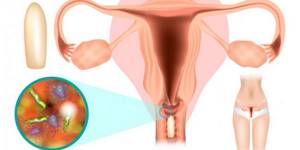
Causes
Various factors can cause the disease:
- mechanical irritations;
- allergies to intimate hygiene products;
- helminthic infestations (pinworms);
- menopause;
- nervous tension or stress;
- hormonal abnormalities;
- long-term use of antibacterial agents;
- severe infections.
With vulvovaginitis, the labia minora often hurt. Large ones begin to hurt only with severe or advanced pathologies.
Symptoms
More often, ladies complain that the left labia hurts or a similar symptom appears on the right. But bilateral damage to the labia is also possible.
In addition to pain there appears:
- greenish vaginal discharge;
- itching and redness of the labia;
- discomfort when urinating.
Sexual intimacy increases the discomfort and women note that after sex the labia hurt more.
Treatment
The main therapy is aimed at eliminating the cause of vulvovaginitis:
- for helminthic infestations, anthelmintic drugs are prescribed;
- if the disease is provoked by stress, then sedatives and tranquilizers are prescribed;
- when the disease is provoked by mechanical irritations, it is recommended to select comfortable underwear from “breathable” fabrics;
- for allergic reactions, antihistamines are prescribed;
- If the cause is hormonal abnormalities, then the hormone levels are restored with the help of medications.
In rare cases, antibiotics or antifungal drugs are used.
To eliminate painful irritation on the labia, it is recommended to wash with chamomile infusion or a weak solution of potassium permanganate.
After eliminating the cause of vulvovaginitis, patients are prescribed a course of medications that help restore vaginal microflora.
Who will help
It is recommended to start the examination with a visit to the gynecologist. If necessary, the doctor will refer you for a consultation with an allergist, gynecologist or other specialists.
Bartholinitis
The Bartholi glands are located on both sides of the entrance to the vagina and when the gland becomes inflamed, a dense ball appears inside the labia minora.

Causes
The main function of the glands is to secrete vaginal lubrication. When the duct is blocked, inflammation occurs.
The reasons for the development of bartholinitis have not been fully identified. Doctors suggest that the appearance of the disease can be provoked by :
- urethritis;
- poor perineal hygiene;
- unprotected sex with an unfamiliar partner;
- STD;
- chronic infections;
- vulvovaginitis;
- wearing tight panties made of synthetic fabrics;
- violation of sterility during medical procedures (rare).
The likelihood of bartholinitis increases if a woman suffers from diabetes.
Symptoms
The disease begins with a blockage of the excretory duct, which causes secretions to accumulate inside the gland. First, the woman notes that pain on the ball on the labia appears after intimate contact.
As fluid accumulates, the lump increases in size, stretching the labia, and the tissue around the inflamed gland swells. The seal on the labia hurts constantly, women complain that it hurts to walk and sit.
In addition to pain, there may be:
- weakness;
- increased fatigue;
- fever (with severe inflammation, the temperature rises to high numbers).
When pressing on the swelling on the labia, the pain intensifies, and pus may appear from the gland duct.
Lack of treatment leads to the development of an abscess of the labia.
Treatment
To eliminate the inflammatory process in the Bartholi gland, it is used:
- antibiotic therapy;
- painkillers;
- warm sitz baths with Chlorhexidine or Miramistin;
- vitamin therapy.
After the acute inflammation subsides, physiotherapy is prescribed.
In case of abscesses or severe bartholinitis, surgical intervention is performed. The gland cavity is opened and cleared of purulent accumulations. In the postoperative period, a course of antibiotic therapy is carried out.
Who treats
If a lump appears on the labia, you need to visit an antenatal clinic.
Cracks on the labia in women
Cracks in the labia appear if the integrity of the mucous membrane in women is compromised. They are formed as a result of internal or external causes. The first include inflammatory processes in the body and diseases of the reproductive system.
In these situations, consultation with a doctor and comprehensive treatment are necessary. The second reasons include extraneous factors (for example: wearing tight underwear). The wounds disappear when the irritants are removed.
What are the internal reasons
- The influence of medications - taking a number of medications leads to the formation of a crack between the labia or on them. Both the use of topical ointments and the oral use of tablets can cause this.
These include hormonal medications, antibiotics, and pharmaceuticals for the treatment of viral infections. Some herbal preparations also provoke microtraumas (for example, daily lubrication of the intimate area with tea tree oils).After the woman stops taking the pills or replaces them with other medications, the cracks will go away.
- Vaginal candidiasis - thrush is known to every woman.
This disease causes the active growth of Candida fungi. They begin to multiply when the immune system is weakened. With thrush, women complain not only about painful cracks in the intimate area. The disease is characterized by severe itching of the genitals and burning sensation. Copious white discharge, the consistency of which resembles cottage cheese, pain during urination and sexual intercourse. - Hormonal disorders in the body - upon the onset of menopause, the skin and mucous membranes dry out significantly, as women have a reduced amount of estrogen in the blood.
This provokes the formation of cracks. This group also includes diseases of the endocrine system. Thus, severe itching and cracks in the intimate area are caused by diabetes. - Sexually transmitted diseases – each sexually transmitted infection has its own symptoms.
Often, in addition to discharge with an unpleasant odor and unbearable itching, women’s delicate mucous membranes are injured, microtraumas and cracks appear. If there is no therapy, the situation gets worse. - Ringworm is a fungal infection of the skin. It appears on different parts of the skin, often localized on the labia. Cracks in the mucosa are one of the signs of the disease.
If cracks appear in the intimate area, this is caused by helminthic infestation, lack of vitamins, allergies and other infectious diseases.
External reasons for the appearance
Foreign factors are safe for health. After identifying the main cause of irritation of the vaginal mucosa, its solution, the cracks go away on their own, without special treatment.
Third-party reasons include the following:
- Mechanical injuries to the labia - often serious injuries to the labia minora and vaginal mucosa appear after childbirth and abortion. Cracks may also appear as a result of harsh sexual contact, inaccurate depilation of the skin, or damage due to exposure to latex.
- Incorrect and untimely personal hygiene of the body - infrequent washing leads to the accumulation of discharge and urine residues between the labia in women. This causes bacteria to multiply, irritate delicate skin and lead to cracks.
- Wearing tight underwear made of synthetic materials - artificial fabrics impede the penetration of oxygen. As a result, the skin of the labia does not breathe, which causes microcracks to appear. A similar situation is sometimes observed with panty liners or tampons.
- Excessive use of cosmetics - constant use of intimate hygiene gels, creams and other scented products leads to dry skin. This invariably causes irritation and cracks on the labia.
What types of cracks are there?
There are two main types of pathology: chronic and acute cracks. The first ones appeared in women a long time ago, but there was no treatment, so the wounds became calloused. They cause pain even if you don't touch them.
Sharp cracks are microtraumas that have appeared recently. They cause discomfort when touched. Pathology indicates the onset of an inflammatory process in the body.
Drug treatment
If microtraumas appear, you should consult a gynecologist. The doctor will conduct an examination, collect a medical history and give directions for the necessary tests. Usually it is required to take a general blood and urine test, bacterial culture for vaginal microflora and tests for the presence of sexually transmitted infections. After receiving the results, the doctor will make a diagnosis and prescribe treatment.
Therapy depends on the specific disease and what pathogens it is caused by. For viral infections, antiviral drugs are prescribed. Most sexually transmitted diseases are caused by bacteria. They are most sensitive to penicillin, cephalosporin and macrolide antibiotics.
If the cracks are caused by vaginal candidiasis or other fungal diseases, then it is advisable to take antifungal drugs.
Along with taking the main active medications, it is recommended to take probiotics, immunomodulators and vitamins.
During treatment, you should maintain sexual rest. The sexual partner of the sick woman should also be checked and undergo preventive treatment.
Home methods
You can relieve inflammation and cure cracks in the labia majora using folk methods. But they must be agreed with the attending physician.
Home methods cannot replace primary drug therapy. They should be considered as additional treatment.
- The most common and effective remedy is considered to be calendula lotions. To prepare the solution, take a tablespoon of dry herb. Brew it with 70 milliliters of boiling water, then evaporate over low heat until half the broth remains in the saucepan. Then cool and strain. Make lotions from the resulting product once a day. The solution quickly heals small cracks.
- Infusion of yarrow and dandelion. Take a teaspoon of yarrow and brew it with a glass of boiling water. Add a small spoonful of dried dandelion root. Take the product twice a day before meals.
- It is recommended to treat the affected areas of the labia with a weak solution of Chlorhexidine. An antiseptic with 2% active substance content helps well.
Before using decoctions of medicinal herbs, you need to check whether you are allergic to them. If you have allergic reactions, then you should not use this product.
Genital herpes
Small blisters appear on the labia, which hurt when pressed or rubbed against clothing.

Causes
The disease is caused by the herpes virus. Infection occurs:
- during sexual intercourse;
- self-infection (due to poor personal hygiene, when herpetic rashes are on other parts of the body);
- when visiting public places (baths, swimming pools).
Self-infection is more common when the herpes virus enters the genitals from other parts of the patient’s body.
Symptoms
With herpetic rashes on the labia, the pain is insignificant. Typically, patients complain of burning and itching in the genital area.
When examining the perineum, small vesicular elements are visible. The skin at the site of the rash is swollen and red.
After a few days, the vesicular vesicles burst on their own, forming erosions.
In women, in addition to the labia, herpetic rashes appear in the vagina and on the cervix.
On average, it takes about 3 weeks from the moment the first blisters appear until the erosions heal. Then the external signs disappear, and the disease goes into a latent form with periodic exacerbations. Often relapses occur before menstruation or against the background of hypothermia.
Causes of calluses on the penis
The causes of penile rashes may be:
- Venereal diseases. A common cause of such rashes is genital herpes. In this case, blisters may appear on the head and foreskin of the penis, in the groin area and along the inner thighs. As a rule, the appearance of calluses is preceded by the appearance of other symptoms: general malaise, sleep disturbance, chills and fever. The symptoms are similar to the flu, but the next day characteristic rashes appear on the male penis. At first, the blisters are not a problem, but over time they become itchy and burst. Later, the rash may go away, but this does not mean that the disease has been cured, the incubation period has simply passed, but over time the disease can make itself felt again. It is best to consult a doctor with such symptoms to prescribe effective treatment for genital herpes;
- Due to mechanical impact. So, a callus may appear on the penis immediately after sex - this is an example of calluses that appear due to mechanical stress. In addition, such injury often occurs in young people who often engage in dry masturbation (without lubrication);
- Balanoposthitis is inflammation of the head of the penis. Signs: calluses appear on the head of the penis, and are accompanied by pain, burning and redness. These are symptoms of the inflammatory process that may accompany balanoposthitis. The cause of the disease may be inflammation or gangrene. This disease needs to be treated, so seek help from a urologist;

Allergic rash on the genitals - Allergy. Calluses on the penis can be a symptom of an allergy, which can be triggered by the following: lubricant, laundry detergent or condoms. In addition, new underwear or new toilet soap can become a source of allergies.

Medical examination and consultation
Treatment of such a disease occurs only after determining the causes of its occurrence, and only then can one begin to treat the penis affected by rashes.
Therefore, when an illness appears, it is necessary to consult with a specialist; only he can reliably recognize the cause of the disease and prescribe effective treatment.
Varicose veins
Varicose veins do not always develop on the legs. Pathological expansion of veins can appear on any organ.

Causes
Due to stagnation of blood in the pelvis, pathological expansion of the veins on the labia occurs. Provoke the development of the problem:
- physical inactivity;
- excess body weight;
- sedentary work;
- pregnancy.
Women with reduced venous tone are predisposed to developing the disease.
Symptoms
With varicose veins, the pain in the labia is moderate and aching in nature.
Due to impaired blood flow, the labia increase in size, and venous nodes protrude under the skin. The woman feels, in addition to pain, an unpleasant heaviness and dryness in the perineum.
With varicose veins, the labia hurt more severely during menstruation and during sex.
Treatment
It is impossible to cure varicose veins, so therapy is aimed at reducing the severity of the disease:
- Dieting. Refusal of fatty foods, pickles and smoked foods will improve the functioning of blood vessels.
- Increased activity. Running, brisk walking or swimming will help eliminate congestion.
- The use of venotonics. To reduce venous nodes, it is recommended to apply Troxevasin or Lyoton externally.
- Prevention of thrombosis. In case of increased blood viscosity, Heparin ointment is prescribed to prevent the formation of blood clots in the venous node.
For severe pain, analgesics are prescribed.
If the venous nodes are large, then sclerotherapy is performed. Patients are injected into a vein on the labia with a special agent, which causes the venous walls to lose their elasticity and collapse, not blocking the vascular lumen. The procedure is done on an outpatient basis under local anesthesia. After sclerotherapy, a woman experiences moderate pain in the labia for several days .
Who will help
Angiosurgeons treat varicose veins. In mild forms of the disease, it is allowed to be treated by a gynecologist.
What to do if you cut your labia?
- Reasons for the formation of wounds in intimate places
- Solution
When a woman cuts her labia, many questions arise: is it dangerous, and how to regenerate the damaged area. To tighten the skin on the half lip, you need to use certain ointments, gels, and creams. You should first familiarize yourself with all the nuances of the recovery period.
Solution
The therapeutic regimen is prescribed by a dermatologist after examining the patient. Skin pathologies are treated with medications and may recur. Before starting to fight them, it is important to follow preventive manipulations. These include the following aspects:
- following hygiene rules;
- use of high-quality cleaning products;
- refusal of aggressive types of sex;
- use of barrier contraception;
- nutrition optimization;
- taking vitamin complexes.
Basic treatment is aimed at eliminating the infection: taking antimicrobial and antibacterial drugs. Therapy is carried out with the additional use of local agents such as ointments, gels, bath solutions, suppositories.
Luracil suppositories, Levomekol and Betadine ointments are widely prescribed to restore the integrity of the labia. In the case of a complicated course of the pathological process, Ecmonovicillin and Penicillin are indicated. High results are guaranteed by taking antibiotics of the cephalosporin group - Tarivid, Ceftriaxone.
In the form of antispasmodic drugs, Baralgin and Analgin are prescribed. Among enzyme agents, Trypsin or Himopsin is in demand. When herpes has been identified, Acyclovir is prescribed. For infections, irradiation with a Minin lamp effectively helps.
If the disease is of an allergic nature, the therapeutic regimen includes antiallergic medications. Effective treatment is impossible without taking immunomodulatory drugs, vitamins and gamma globulin.
When a woman cuts her labia while shaving, it is necessary to abandon the procedure until complete healing. Prescribe products that restore skin regeneration such as Boric ointment, Levomekol. They are applied to intimate organs over a course of 5-7 days.
After the skin has healed, it is advisable to change the method of getting rid of unwanted hairs to an electric razor, laser hair removal, or use wax. Among modern methods of hair removal from intimate places, sugaring stands out.
The procedure provides smooth skin for 2-3 weeks.
Loading…
Source: https://uginekologa.com/chto-delat-esli-porezala-polovuyu-gubu.html
Gardnellez
The disease is one of the types of vaginal dysbiosis.

Causes
The opportunistic bacterium Gardenella begins to multiply when the level of beneficial bacteria in the vagina decreases. Provokes the development of pathology :
- decreased immunity;
- abuse of douching;
- inflammation of the reproductive organs;
- hormonal changes provoked by endocrine diseases or menopause;
- promiscuity;
- refusal of lactic acid products.
Gardnellosis may also be caused by the use of vaginal spermicidal gels.
Symptoms
The labia are sore and swollen. Additionally appear :
- Copious vaginal discharge. The discharge looks like clear mucus with a characteristic onion or fishy odor. In severe forms of the disease, the mucus becomes greenish or grayish in color.
- Difficulty urinating. The symptom appears when the pathological process affects the urethra.
With advanced gardnellosis, the pain and swelling are so severe that it is difficult for a woman to walk and sit.
Treatment
Therapy is carried out with antibacterial drugs:
In severe cases of the disease, the drugs are prescribed orally and the external use of ointments, sprays and vaginal suppositories is additionally prescribed. For mild forms of the disease, drugs are used only externally.
Who will help
Treatment of gardnellosis is carried out by a gynecologist.

The labia do not always hurt due to a pathological process
Let's consider when pain in the labia is not considered dangerous:
- Pregnancy . After conception, blood flow to the reproductive organs increases. Because of this, the labia become slightly swollen, the skin becomes slightly darker, and minor pain may be experienced. There is no treatment for pain in the labia during pregnancy. To reduce discomfort, women are advised to choose comfortable, seamless underwear, stand or sit less, and walk daily.
- Postpartum period . If after childbirth you feel like there is pain between the labia and vagina, then this is normal. Sprains and micro-tears that occur during the birth of a baby take a long time to heal. To reduce the risk of infection or other complications, you must follow your doctor's recommendations.
- Allergy . Often, everyday use of scented pads causes an allergic reaction. Pain in the labia is moderate.
But even if it seems that the cause of pain in the labia is pregnancy or allergies, you should not neglect a visit to the gynecologist. Pregnancy often provokes varicose veins of the labia, and allergic reactions cause vulvovaginitis.
When is it necessary to visit a doctor?
If pain in the labia appeared once and soon disappeared, then there is no need to worry. The reason for consulting a doctor should be:
- One-sided pain . The labia majora may hurt due to varicose veins, bartholinitis or neoplasms.
- Hurts badly . When severe painful discomfort appears in the labia, this indicates a pathological process.
- Vaginal discharge . If, in addition to pain in the labia, the volume of vaginal mucus has increased or the discharge smells unpleasant, this indicates a bacterial or fungal infection.
If the labia are sore, this almost always indicates problems with women's health. You cannot self-medicate and take painkillers. Only a doctor can identify the cause and select the necessary medications. Timely seeking help will help avoid gynecological complications and preserve women's health.
Found an error? Select it and press Ctrl+Enter.
